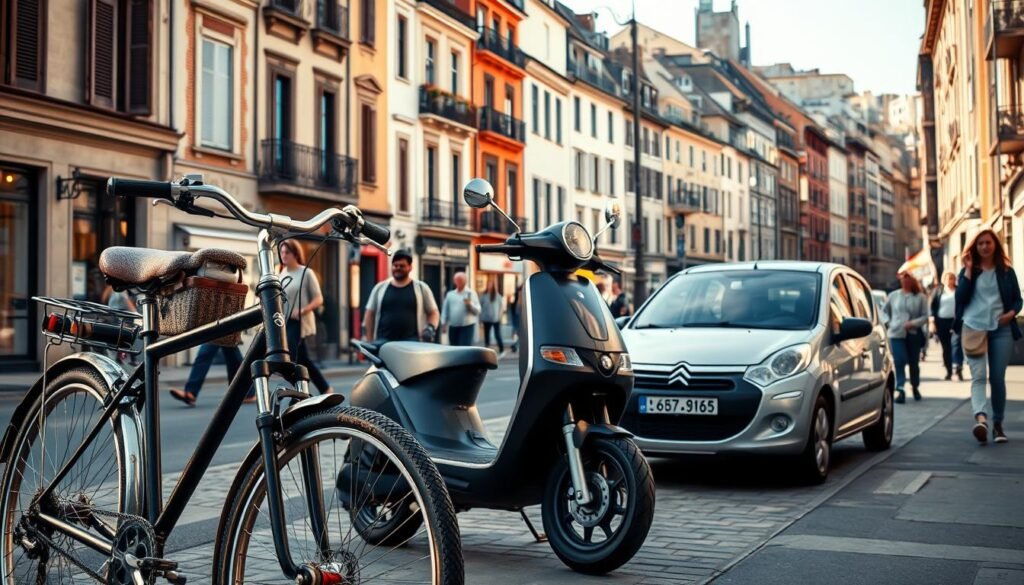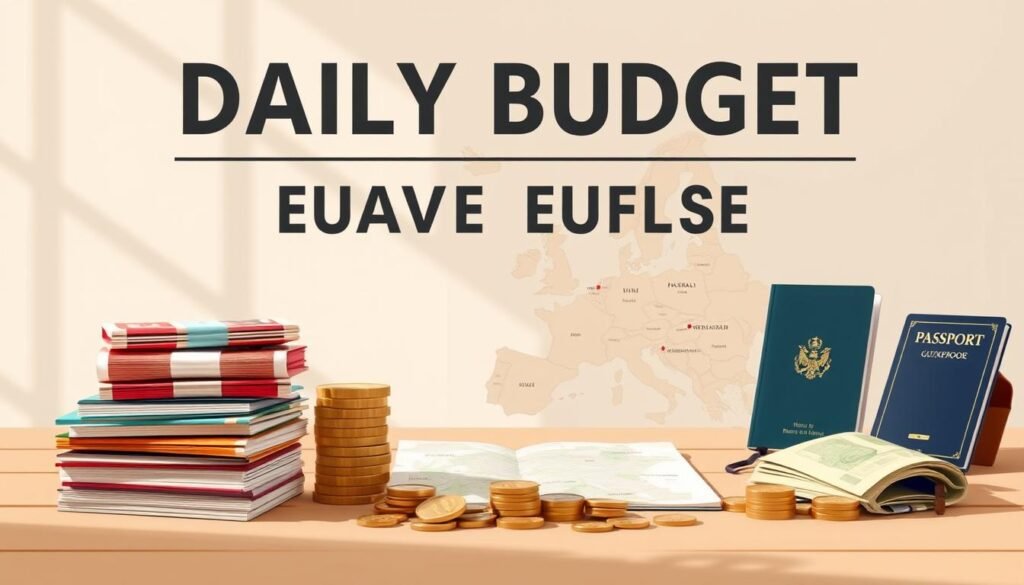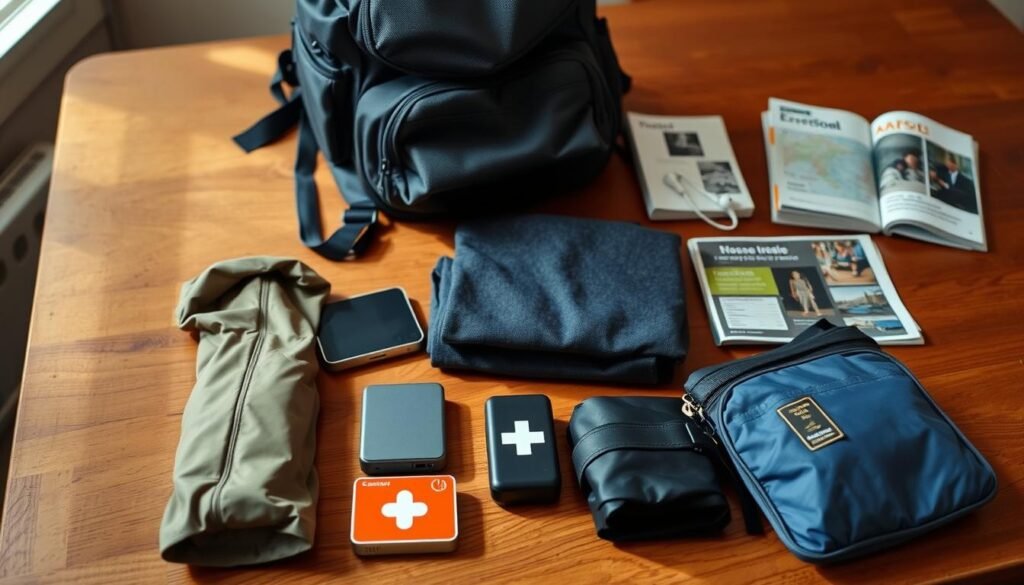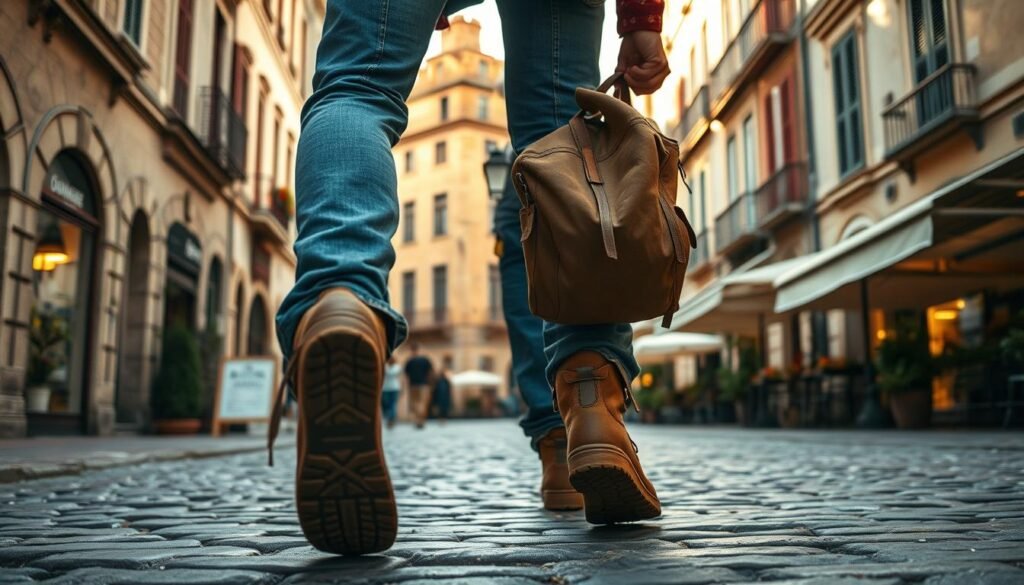Traveling through Europe can be thrilling, but it’s often pricey. Yet, with some planning and creativity, you can explore Europe on a tight budget. Many have backpacked Europe for under $30/day and succeeded.
By watching your spending and making smart choices, you can enjoy Europe’s history, culture, and beauty without spending a lot. Budget-friendly accommodations, cheap meals, and free or low-cost sights are key to saving money.
Key Takeaways
- Plan ahead to save on accommodations and transportation
- Research affordable dining options and local cuisine
- Take advantage of free or low-cost attractions and activities
- Be flexible with your travel dates to secure better deals
- Pack smart to avoid unnecessary expenses
Planning Your Budget European Adventure
Planning a European trip on a budget is more than just saving money. It’s about making choices that make your trip better. You need to plan well, thinking about a few important things.
Setting Realistic Expectations and Goals
It’s important to set realistic goals for a stress-free trip. Remember, budget travel means making some sacrifices. Figure out what you really want to do and spend your money on those things. For example, if you love trying new foods, you might spend less on where you stay.
Best Times to Visit for Budget Travelers
The best time to visit Europe on a budget is in the shoulder season. This is April-May and September-October. The weather is nice, and there are fewer people, making places more affordable. Try to avoid the peak season, as prices for hotels and attractions go up a lot.
Creating a Flexible Travel Timeline
Being flexible is crucial for a budget trip. Make a basic plan, but leave room for surprises. Use budget airlines and rail passes to get around. A flexible plan lets you find deals or follow local tips.
| Month | Weather | Tourist Season | Budget Friendly |
|---|---|---|---|
| April | Mild | Shoulder | Yes |
| July | Hot | Peak | No |
| September | Warm | Shoulder | Yes |

Creating a Budget-Friendly Itinerary
Planning a budget-friendly trip to Europe is key for travelers on a tight budget. A good plan saves money and makes your trip better. It ensures you use your time and resources wisely.

Choosing Affordable Destinations in Eastern and Southern Europe
Eastern and Southern Europe have many affordable places full of culture and history. Countries like Poland, Hungary, and Croatia are cheaper than Western Europe. For example, Budapest in Hungary or Krakow in Poland are cheaper than Paris or Rome but just as rewarding.
Balancing Popular Cities with Lesser-Known Gems
Big cities like Berlin and Barcelona are great but can cost a lot. Mixing in smaller towns can save money. Places like Plovdiv in Bulgaria or Ljubljana in Slovenia are charming and less crowded, offering a budget-friendly trip.
Strategic Route Planning to Minimize Transportation Costs
Planning your route well can cut down on travel costs. Use budget airlines, rail passes, and night buses to save. Avoid backtracking and use public transport in cities to save even more. For example, a Eurail pass can be cheaper than buying individual tickets.
By choosing the right places, balancing big cities with small towns, and planning your route, you can have a budget-friendly trip. You’ll enjoy Europe’s beauty without spending too much.
Transportation Strategies to Save Money
Traveling through Europe doesn’t have to be expensive. You can use budget airlines, rail passes, and other affordable ways to get around. This way, backpackers can explore the continent without spending a lot.
Budget Airlines and Rail Passes
Flights with airlines like Ryanair, EasyJet, and Wizz Air are cheap. Rail passes, like Eurail, let you travel by train across many countries. They’re flexible and save money.
Key Benefits: Wide network, good prices, and lots of options.
Public Transportation Options in Major European Cities
European cities have great public transport. You can use metro lines, buses, and trams. City passes or travel cards let you travel all you want for a set time.
Hitchhiking and Ridesharing Considerations
Hitchhiking and ridesharing are cheap and fun. They’re great for meeting people. Sites like BlaBlaCar help find rides.
Night Buses and Trains as Transportation and Accommodation
Night buses and trains are good for saving on hotels. FlixBus runs many night bus services. They’re a cheap way to travel.
Here’s a comparison of different transportation modes:
| Mode | Cost | Convenience | Scenic Route |
|---|---|---|---|
| Budget Airlines | Low | High | No |
| Rail Passes | Variable | High | Yes |
| Public Transport | Low | High | No |
| Night Buses | Low | Medium | Yes |

By using these travel tips, backpackers can have a fun and affordable trip in Europe.
Finding Affordable Accommodation
Traveling Europe on a budget is possible. You can find cheap places to stay with some planning. This way, you can enjoy your trip without overspending.
Hostel Hacks and Booking Tips
Hostels are great for budget travelers. They offer dorms and private rooms at low prices. To save, book early and look for hostels with free perks like breakfast.
Use websites like Hostelworld and Booking.com to find deals. Filter by price, location, and reviews. Booking off-season or on less busy days can also save you money.
Couchsurfing and Hospitality Exchanges
Couchsurfing lets you stay with locals and save money. It’s a chance to see how locals live. Sites like WarmShowers and BeWelcome offer similar experiences.
“Couchsurfing has been a game-changer for my travels. It’s not just about saving money; it’s about connecting with people and experiencing the culture firsthand.” – Sarah, avid traveler
Budget-Friendly Alternatives: Camping and Work Exchanges
Camping is a cheap way to enjoy the outdoors. Europe has many campsites, from simple to fancy. Work exchanges let you work for room and sometimes food. Sites like Workaway and WWOOF can help you find these.
| Accommodation Type | Average Cost | Benefits |
|---|---|---|
| Hostel Dorm | $15-$30 | Social atmosphere, free amenities |
| Couchsurfing | Free | Local culture experience, no cost |
| Camping | $5-$15 | Outdoor experience, budget-friendly |
| Work Exchange | Free (in exchange for work) | Accommodation, meals, local experience |
Booking Strategies and Timing for the Best Deals
Booking at the right time can get you better rates. Early or last-minute bookings might offer discounts. Use tools to compare prices and set alerts for deals.

By using these tips and being flexible, you can find affordable places to stay in Europe. This way, you can enjoy your trip without breaking the bank.
Eating Well on a Tiny Budget
Eating well on a small budget is possible with a few tips. Traveling through Europe can be a food adventure. You’ll find many tasty and cheap food options from different cultures.

Self-Catering and Grocery Shopping in Different Countries
Self-catering is a great way to save on food. Many hostels have kitchens for you to cook. Grocery shopping lets you try local foods at lower costs.
In Germany and the Netherlands, Aldi and Lidl have affordable groceries. Southern Europe’s markets offer local foods and ingredients at low prices.
| Country | Average Grocery Cost per Week | Popular Grocery Stores |
|---|---|---|
| Germany | $20-$30 | Aldi, Lidl |
| Italy | $25-$35 | Conad, Lidl |
| Spain | $25-$40 | Mercadona, Dia |
Finding Affordable Local Eateries
Eating out doesn’t have to be pricey. Look for local spots, cafes, or food stalls with good prices. Stay away from tourist areas to save money. For example, in Portugal, try a pastel de nata for under $2.
Street Food and Market Meals Worth Trying
Street food is tasty and cheap. From Belgian fries to Greek gyros, Europe has lots to offer. Markets also have affordable ready-to-eat meals. In Hungary, try langos from vendors, and in the UK, enjoy a traditional pasty.
By following these tips, you can enjoy Europe’s food scene without breaking the bank. Whether cooking yourself, eating at local spots, or trying street food, there’s something for every taste and budget.
How to Backpack Europe for Under $30/Day: Daily Budget Breakdown
Effective daily budgeting is key for a great European backpacking trip. Knowing how to spend your money can greatly improve your journey.

Sample Daily Spending Plan by Region
Different parts of Europe cost differently. Eastern Europe is often cheaper than Western Europe. Here’s a daily spending guide:
| Region | Accommodation | Food | Transportation | Total |
|---|---|---|---|---|
| Eastern Europe | $8 | $6 | $4 | $18 |
| Western Europe | $12 | $8 | $6 | $26 |
Tracking Expenses Effectively with Apps and Tools
Apps and tools can help you keep track of your spending. Trail Wallet and Splitwise are great options. They let you see your spending in real-time, helping you stay on budget.
Building in Buffer for Occasional Splurges
It’s smart to have a little extra money for treats or surprises. Set aside a small part of your daily budget for these. This way, you can enjoy your trip more without overspending.
By using these tips and watching your spending, you can have a great time backpacking Europe for under $30/day.
Free and Low-Cost Activities Across Europe
Exploring Europe doesn’t have to cost a lot. There are many free and low-cost activities to enjoy. You can see historical sites and natural wonders without spending much.

Museums and Cultural Sites with Free Entry Days
Many museums in Europe let you in for free on certain days. For instance, the Louvre in Paris is free on the first Saturday of every month from October to March. By looking up these free days, you can save money and still see famous museums.
Self-Guided Walking Tours and Free City Tours
Explore European cities on your own with walking tours. Many cities offer free tours that rely on tips. This way, you can see historical sites and learn about local culture without spending a lot. Cities like Rome, Barcelona, and Prague have easy-to-follow routes.
Enjoying Nature and Outdoor Activities
Europe has beautiful landscapes, from the Alps to the Mediterranean coast. You can hike, swim, or have a picnic in parks and reserves. These activities are cheap and a great way to relax from city life.
By using these budget travel tips, you can have a great time in Europe without breaking the bank. Whether you love culture, history, or nature, there’s something for you.
Money Management for American Travelers
Managing your money well is key when backpacking in Europe on a tight budget. With smart planning, you can have a great time without spending too much.
Best Cards and Banking Options to Avoid Fees
Choosing the right bank card can save you a lot on foreign transaction fees. Look for cards with no foreign transaction fees, like the Chase Sapphire Preferred or Capital One Venture. Also, tell your bank you’re traveling to avoid any issues with your card.
| Card Name | Foreign Transaction Fee | Annual Fee |
|---|---|---|
| Chase Sapphire Preferred | $0 | $95 |
| Capital One Venture | $0 | $95 (first year free) |
| Discover it Cash Back | $0 | $0 |
Currency Exchange Tips and Traps to Avoid
Avoid exchanging money at airports or tourist spots, as the rates are bad. Use ATMs to get local currency or exchange a bit at your bank before you go. Watch out for dynamic currency conversion scams, where merchants charge you in USD at a bad rate.

Emergency Funds and Safety Precautions
It’s important to have an emergency fund for unexpected costs. Keep a backup credit card or some cash safe. Stay updated on local news and take steps to protect yourself from theft or loss.
By using these money tips, American travelers can have a fun and affordable trip in Europe, all for under $30/day. Good financial planning makes your trip worry-free and enjoyable.
Essential Packing for Budget Travelers
Packing lightly is key for budget travelers. When exploring Europe on a tight budget, every item matters. The right packing can save you money and trouble.

Minimalist Packing Strategies for Different Seasons
Europe’s climates vary, so packing smart is essential. For summer travel, choose light, breathable clothes that layer well. In winter, pack warm layers that adjust to indoor heat.
Think about your activities. For hiking, sturdy shoes are a must.
- Choose multi-purpose items, like a sarong that can serve as a blanket, towel, or dress.
- Use packing cubes to organize your luggage and compress your clothing.
- Roll your clothes to save space and reduce wrinkles.
Money-Saving Items to Bring From Home
Bringing some items from home can save you a lot of money. Consider packing:
- A refillable water bottle to avoid buying bottled water.
- Your own toiletries to avoid overpriced tourist areas.
- A portable charger to keep your devices powered up on the go.
- Snacks, like nuts or dried fruit, to curb impulse buys.
By using these packing strategies and bringing the right items, your European trip can be more affordable and enjoyable.
Conclusion: Making the Most of Your Budget European Adventure
Backpacking Europe on a budget is an exciting journey that needs planning and flexibility. By setting realistic goals, picking affordable places, and watching your spending, you can have a great time for under $30/day.
Planning your route, staying in budget-friendly places, and choosing smart ways to travel make the trip fun. You can also eat well without spending a lot by cooking your own meals, trying street food, and visiting local markets.
By using the tips from this article, you can have a fantastic time in Europe without breaking the bank. Whether you’re checking out cultural spots, enjoying outdoor activities, or just taking in the vibe, a budget trip to Europe can change your life.

